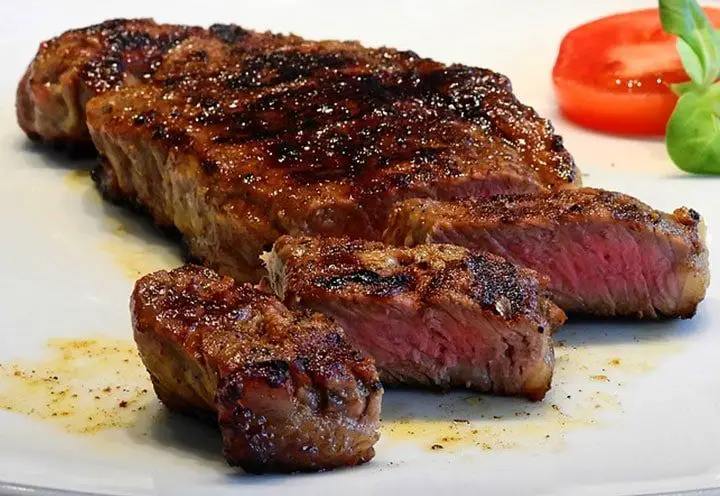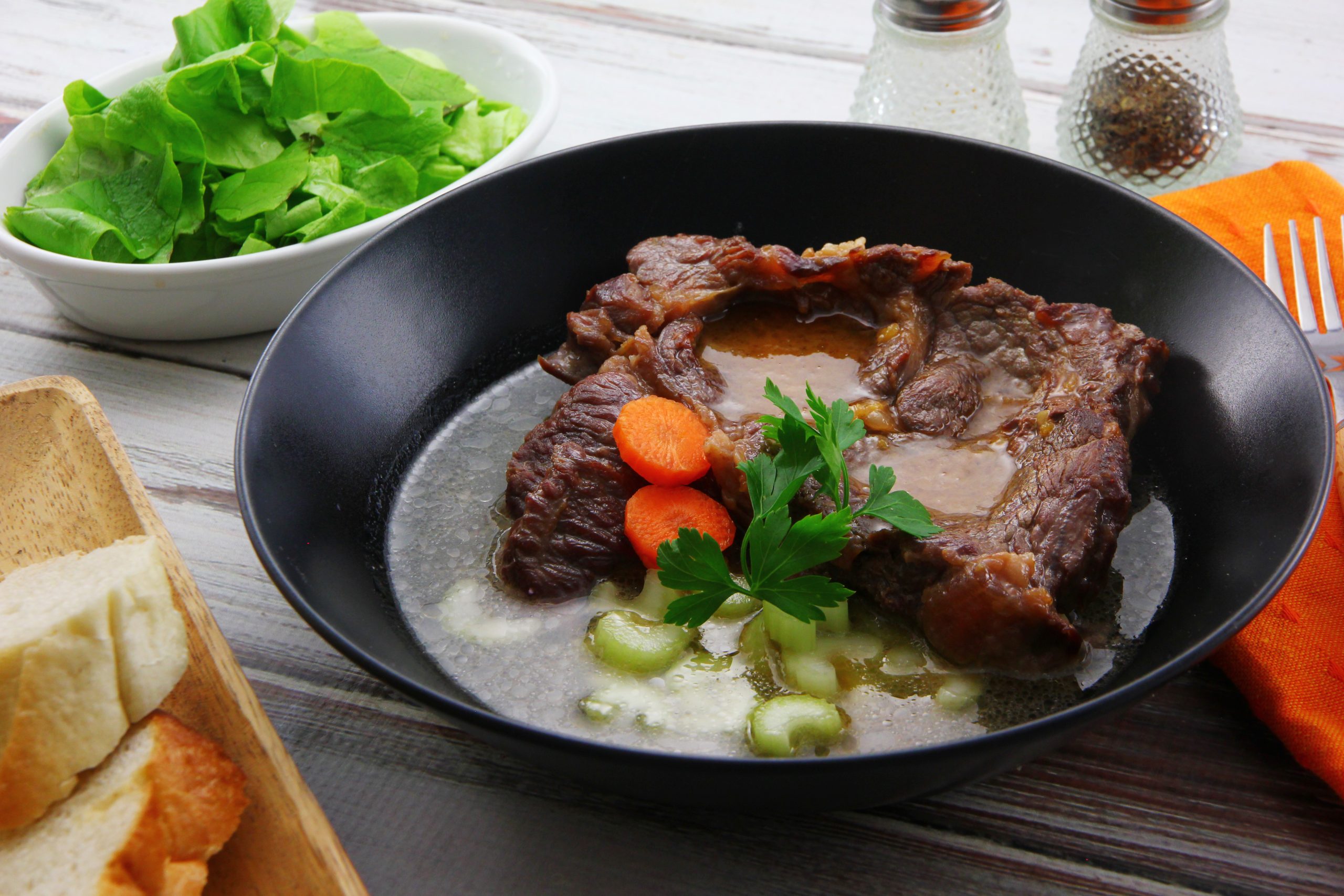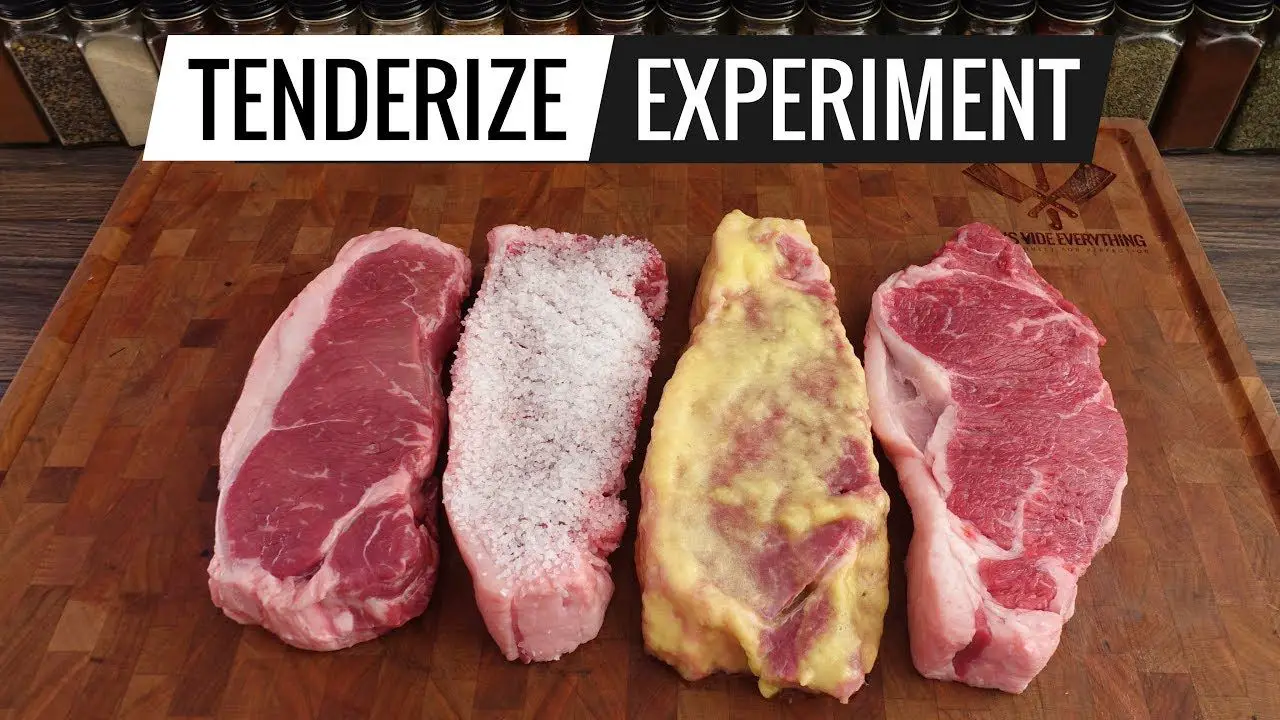Tenderizing Meat Using Baking Soda
Using baking soda is an excellent option for those who want to tenderize their meat quickly. Apparently, baking soda has alkaline properties renowned for breaking up protein bonds quickly and effortlessly thus turning tough cuts into tender meat.The only concern with using baking soda is the taste. The alkaline taste never seems to go away even after rinsing your meat thoroughly in running water. With this in mind, you should use baking soda to tenderize meat if you dont mind the vague alkaline taste remaining in your meat.Interestingly, baking soda works well with all types of meat. You can use it to tenderize your tough beef cuts and pork chops without much fuss. However, we recommend this method for the smallest and thinnest cuts to get the best results.
Distinguish Tough From Chewy
Tough meat can certainly be chewy. But toughness and chewiness are not really synonymous. Chewiness is related to connective tissue and the length of the muscle fibers.
Connective tissue can mean thick pieces of gristle in between muscles, or it can mean the sheets of fibrous collagen that surround muscle fibers. Either way, connective tissue is chewy. And it only gets chewier when it’s cooked improperly.
Finally, not all muscles have the same structure. Muscles are composed of fibers, basically long strands of protein grouped together in bundles, that are in turn wrapped in sheaths of collagen. Some bundles have more fibers in them than others, making the grain of the meat coarser, such as with a brisket. Long, thick muscle fibers will be tougher to chew.
How To Tenderize Your Steak With Salt:
Step #1: Take a clove of garlic and rub all sides. This adds just a hint of garlic flavor.
Step #2: Sprinkle kosher salt all over the steak. You will want to use about 1 teaspoon per side. Let set for 1 to 2 hours.
DES TIP: Do not use table salt. Because of its fine grain it will dissolve too much into the steak and make it too salty.
STEP #3: Rinse steak and pat dry with a paper towel. Season with your favorite steak seasoning.
STEP #4: Depending on the thickness of the steak, grill 3 5 minutes per side for medium rare. Then allow to rest 10 minutes before slicing.
Don’t Miss: Does Mcdonald’s Still Have Steak Bagels
Tenderize Meat With Brawn
You can also break down the collagen in meat with a mallet. This is a useful technique for tenderizing a steak. There are a number of fancy machines and tools to do this, but the most basic way is with a wooden or metal meat mallet.
Meat mallets usually have two surfacesa flat side and a side with a lot of little points on it.
Pounding a steak with the pointy side of the mallet will cut up the connective tissues as well as the muscle fibers themselves. This allows a steak with a lot of connective tissue to be cooked over high heat without being too tough to eat.
Steaks tenderized like this are sometimes called cube steaks, because the indentations created by the mallet are shaped like cubes.
Cube steaks won’t be as succulent as braised beef chuck, for example, and you’ll certainly never mistake them for beef tenderloin. But pounding is a quick and easy way to tenderize a steak.
Pounding also has the advantage of flattening the meat, which allows it to cook more quickly and more evenly. The longer a steak spends over the heat, the drier it gets. And since dry meat is tougher, preserving the juices will produce a more tender steak.
What Is Flank Steak

Flank steak, sometimes known as London broil, is a cut of beef taken from the animal’s abdominal muscles. Its typically about a foot long and an inch thick. Its usually cooked whole.
Theres some debate as to whether flank steak is technically steak at all. The Oxford English Dictionary defines steak as High-quality beef taken from the hindquarters of the animal. However, its a popular cut of beef that can be the star of the meal or an essential supporting player depending on the recipe.
Read Also: Steak Of The Month Club Butchers Market
How Long To Marinate A Steak
Tender steaks like ribeye or sirloin should marinate for a maximum of 4 hours. As theyre already tender, you dont want to marinate longer than that or the meat will break down too much and the texture can become unpleasant.
A tougher cut of steak like a flank steak, skirt steak, or even chuck can marinate longer, up to 24 hours .
Best Way To Tenderize A Steak
The best method for tenderizing your steak depends on the cut and how you plan on cooking it. Obviously, you can slowly cook some cuts on a smoker, or braise them in a flavorful liquid in an oven, slow cooker or pressure cooker.
When it comes to firing up your grill, however, these are the 5 best options for tenderizing a steak. These methods are ideal for the high-heat searing and grilling that produce the most flavorful and delicious BBQ steaks.
Read Also: How Long Will Omaha Steaks Stay Frozen During Shipping
Why Salt And How It Works
I know that you are asking yourself, that doing so, will make you steak over-salty. Your friends are thinking the same thing. How the heck is tenderizing a steak with so much salt going to work. Let us explain.
The salt will draw out the natural juices of the meat. Over a long period of time, the salt would cure the meat. You would do this by removing the water and juices as they draw out.
But used as a tenderizer for the meat, when applied and removed accordingly, the juices and salt will create a brine. This brine will reabsorb into the meat and break down the proteins and amino acids.
It is recommended to use kosher salt over your standard table salt.
The coarser grains of the kosher salt are the agents in charge of the muscle, protein breakdown. The smaller granules in table salt wont do an efficient job of breaking the meat down.
This is how salt tenderizes meat and transforms your chewy mass, into a tender edible masterpiece.
Give It Some Knife Work
Just as youd score a duck breast or your holiday ham, do the same with tough flank and hanger steak. By making shallow cuts against the grain in one direction, then another set of cuts the other way, some of the long muscle fibers are severed, leaving the meat with a more tender bite. But keep your expectations in check, because scoring a tough cut of steak certainly isnt going to turn it into filet mignon.
Learn more:Does Scoring a Cheap Cut of Steak Make It More Tender?
Read Also: Creamy Dill Mustard Mcdonalds
Why Should I Tenderize My Steak
Meat, whether red or white, consists of connective tissues that form muscle fibers and the protein myoglobin, which is responsible for the redness of the meat. While in red meat, the muscle fibers are narrower and tightly packed, in white meat, the muscles are more loosely placed.
Based on what section of the animal’s body, the cuts come from, the toughness or graininess of the meat differs.
Cuts such as sirloin, loin, and rib are tender and are usually very expensive. So, if you are working on a budget, then buying such expensive proteins can put a dent on your wallet.
Therefore, the only feasible choice would be to get cuts that are more economical such as shank, chuck, and flank. These steaks are tough yet are very flavorful. However, cooking with tough meat can be troublesome. If they are not tenderized or rendered down, then they become rubbery and tough to eat.
How I Discover Salt As A Secret Tenderizing Ingredient
It all began when I joined my cousins BBQ smoking team. We turned cuts of beef and pork into succulent delicacies using wood, seasonings, and time.
We took a brisket, which is a large muscle from the front chest plate of the cow. Once considered a very cheap piece of the cow, and we made it tender enough that it could be cut with a fork. The trick I learned, was salt.
We would coat the meat in it for a short period of time, rinse it, and then proceed to slow cook it for several hours.
If this could transform a tough cut like brisket, imagine what it could do to a fine steak. So, we decided to share the trick with everyone and teach you this simple trick to tenderize steak with salt.
Read Also: Steak Eze Sams
Tips For Making The Perfect Steak:
Using the salting technique will go a long way in making your steak perfect. But a couple other tips will also help!
Tip #1: After you rinse the steak, do not skip the pat it dry step. If you try to cook the steak wet, it will steam instead of sear.
Tip #2: As true with any steak, you have to got to let it rest. If you cut the meat right away, the juices will seep out. While resting the meat allows the juices to redistribute resulting in a juicer steak.
If youre looking for something to serve along side, here are some of my favorite side dish recipes to serve with steak:
Is Eating This Much Salt Healthy

Yes, that much salt would be detrimental to your health. But you are only going to use salt to tenderize your steak, not eating it.
Once the hour is passed, and you have started your grill, broiler, or skillet, it is time to rinse your steak off.
You can run water over your meat to remove the extra salt. We prefer dunking the steak in a bowl of tap water. Doing so, will ensure that the water is removing the salt entirely.
While in the water, massage the steak further to ensure all the salt is removed. From there, give it a good rinse under the kitchen faucet.
Pat dry your steak with a kitchen towel or a paper towel. Rest your meat on a new plate, season it as you like and then you can start grilling it.
You May Like: Pee Dee Steak House On 125
Why Is My Steak Tough And Chewy
The muscle fibers in meat have to be broken down and the proteins turned into gelatin in order to make meat tender. This happens very quickly over high heat with tender cuts of steak like filet mignon, but tougher cuts of meat require slow cooking, usually in some sort of liquid to keep them from drying out.
How Do You Tenderize Meat With Meat
Simply put it in your tenderizer powder and it is in great shape. Sprinkle the evenly coated powder evenly over each layer of meat, pierce with a fork once the enzyme has penetrated the meat. Once it has ignited, move on to the remaining ingredients. This allows the proteins to be immediately broken down after heat activation.
Don’t Miss: How Long Can Omaha Steaks Stay Frozen
Tenderize Meat With Heat
Meat with a lot of connective tissue can be tenderized by cooking it until the collagen melts away, which starts to happen between 160 and 200 F. When the connective tissue melts, it turns into gelatin, which is soft and jiggly rather than tough and chewy.
This doesn’t happen right away it can take hours. Tenderizing in this manner requires patience, but your patience will be rewarded. Liquefied gelatin coats and surrounds the muscle fibers, giving the meat a moist, succulent textureeven though it’s been cooked to well-done.
One of the main techniques for accomplishing this is braising. This is a moist-heat cooking technique by which meat is immersed at least partially in some sort of liquid that is then maintained at a gentle simmer for a period of time sufficient to break down the collagen.
Another method is a traditional barbecue: Air around the meat is heated to about 225 F it’s cooked for a long time, sometimes eight hours or more.
Either way, melting the collagen in meat tenderizes it and adds to the flavor.
How To Tenderize A Steak: 5 Easiest Ways
Have you ever tried to cook a steak and it came out tough? If so, youre not alone. The problem with cooking steaks is that they can be difficult to get just right. Cooking them for too long will make the meat tough, while undercooking may result in eating raw or undercooked meat.
This article will teach you how to tenderize your steak properly so its juicy, flavorful, and cooked through without being chewy!
Contents
Don’t Miss: Canada Steak Burger Chula Vista
Which Types Of Steaks You Should Tenderize
Consider tenderizing flank steaks, skirt steaks, and tri-tips.
The cuts include massive muscles that are frequently hardened by the grills high heat. Pre-tenderizing these steaks and cutting the meat in a straight line may result in tender and juicy meat.
Tenderizing round, chuck, London broil, and top sirloin steaks is also beneficial. Typically, these less costly cuts have a lower fat content than the more expensive cuts. Additionally, tenderizing the steak breaks down the muscle fibers, keeping it juicy and delicious.
Tenderizing is usually beneficial for less costly steaks for identical reasons, regardless of whether they are higher-end cuts. The less expensive steaks often have less fat marbled into the meat and may also contain a significant quantity of chewy connective tissue.
A tenderizing inexpensive Ribeye or New York strip steak, for example, may aid in breaking up this cartilage and allowing it to cook faster. So that it does not dry out before reaching the required degree of doneness.
Downsides Of Tenderizing Steak
One of the biggest downsides of tenderizing steak is that it can be quite time-consuming, if youre tenderizing large cuts with a mallet this can take you well over an hour.
Not only that but purchasing the tools to tenderize your steak properly is an added expense that some people could do without.
Its also worth noting that you do need to be very careful when tenderizing steak as if you over tenderize, your steak will become mushy as youll break down to enzymes too much.
There is a fine line that with experience youll learn when it comes to tenderizing a steak, so take your time and ensure you only tenderize for roughly 5 minutes per half-inch.
Its better to under tenderize then over tenderize as youll essentially waste your steak if you do it too much.
For me, I personally like to keep my steaks as natural as possible, so adding meat tenderizing powder isnt really an option.
I know that these powders can be effective, but the thought of sprinkling powder on my steak which can have some side effects such as throat irritation, stomach irritation, allergic reaction, and more isnt worth it in my eyes.
This is all down to personal preference and some people will be more than happy to add this to their steaks, but for me, its a downside that is worth mentioning in this article.
You May Like: Seasoning Steak Overnight
How Does Heat Make Meat Tender
Meat is made up of long fibers, each individually wrapped in a sheath of collagen, a connective tissue that, when heated too high, shrinks and squeezes out the juices. That’s why well-done meat is tougher. But if you keep the heat from 160° to 205°F, the collagen begins to gelatinize and the meat gets more tender.
Lets Marinate Some Steak

The aroma this mix gives off before you add the meat is insane. You know its going to be incredible just from by the smell of it. Mix in a small bowl, whisk together soy sauce, lemon juice, olive oil, Worcestershire sauce, minced garlic, Italian seasoning, pepper, salt, and a pinch of red pepper. Add steaks to a resealable zip lock bag or large bowl and pour the marinade on top. Marinate for 2 hours or overnight.
Recommended Reading: How Long Can Omaha Steaks Stay In Shipping Cooler
Surefire Ways To Tenderize Meat
Each of these methods is described fully below.
Tenderizing Meat With Heat
Cooking the meat over low heat for longer periods can help break down the tough muscle fibers and connective tissue. Its an alternative method in meat tenderizing, rather than just using a meat mullet. You can braise, grill, smoke or use a slow cooker to tenderize your meat.As you are aware, meat consists of long fibers surrounded by a sheath of collagen. When heated at 160° F, the layers of collagen will become gelatinous, leaving your meat tender and succulent.However, tendering meat with heat is somehow difficult to hack since you have to maintain the temperature between 160° F and 205° F to prevent the meat from drying out.Even though you can safely cook your tough cuts all day long to make them tender, we do not recommend this since your meat will more likely lose essential nutrients.Tendering meat with heat is ideal for tough cuts such as beef chuck, short loin, shoulder, brisket, rib and butt. This method doesnt work well with filet mignon and pork chops.
You May Like: Does Mcdonald’s Still Have Steak Bagels
